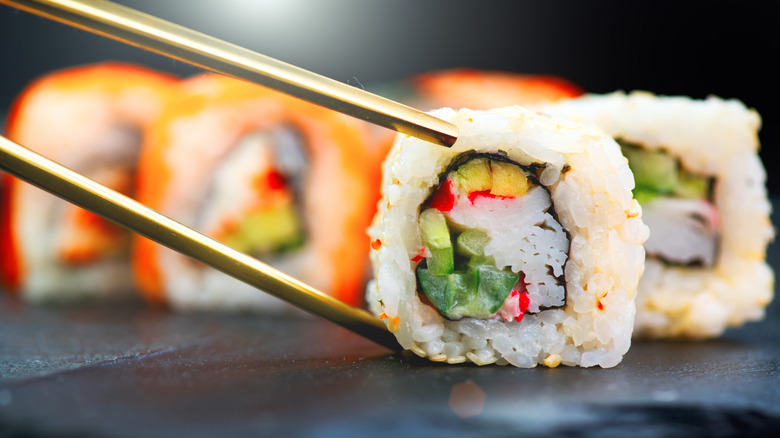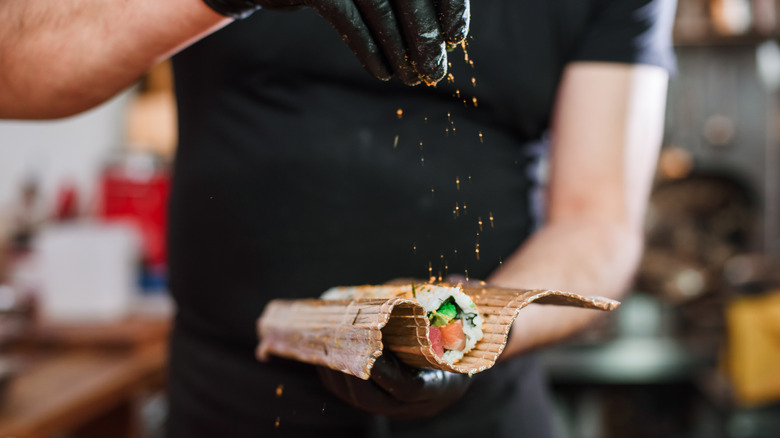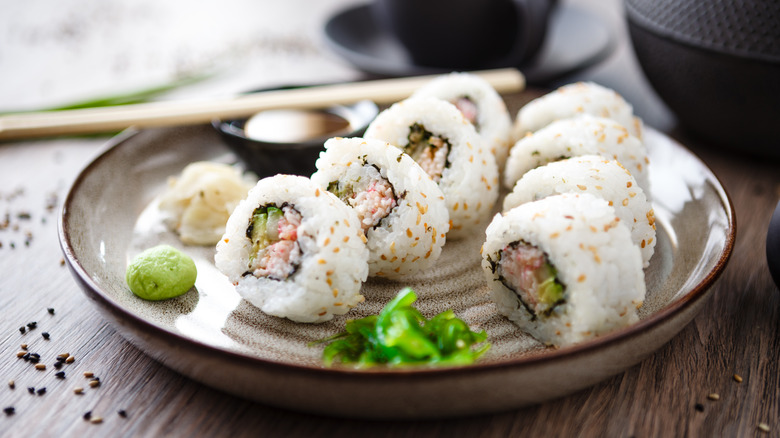What's Really In A California Roll?
If you're like many Americans of a certain age, it's altogether likely that the first time you had sushi, you bit into a California roll. It probably had king crab leg inside, or maybe it was imitation crab stick, known as kanikama in Japan. And there was cucumber, or maybe there wasn't, but there was definitely orange flying fish roe, or tobiko, on top — unless, of course, it was sesame seeds. With so many variables, what really goes into the Golden State's eponymous norimaki and how did it arrive on our menus?
The journey of sushi around the globe is, like that of many foods, a story of necessity, serendipity, ingenuity, and evolution. The History Kitchen points to a 4th-century Chinese dictionary referencing a novel method of food preservation whereby salted fish was nestled in cooked rice and allowed to ferment. From there it traveled across the region, likely with Buddhist monks, proving rather popular, if at first only with the wealthy, in Japan. Innovators, as they are want to do, tweaked and refined sushi, taking it from a mere preparation to a defined dish.
A story of invention and innovation
With its significant Japanese population and ready access to fresh seafood, Los Angeles proved a sturdy toehold for sushi's entry into the U.S. culinary lexicon. In his book "The Sushi Economy," Sasha Issenberg outlines how an enterprising chef named Saito and his wife — with help from Japanese restaurant supplier Mutual Trading Company — introduced the concept of the sushi bar at their restaurant Kawafuku. In an era before easily-accessible and incredibly-rapid global transport, Saito relied on seafood he could procure from local markets to flavor his nigiri and maki.
Much like with other lauded culinary creations, the California roll has more than a few claimants to who invented it. The book "American Tuna" offers a couple of variations on the origin story, but states that it is most likely a 1960's creation of chef Ken Seusa, a Japanese master of the art who wasn't afraid to use familiar, if untraditional ingredients to introduce sushi to Angelenos.
Whereas raw slices of giant clam, tuna belly, or mackerel may have been a bridge too far, avocado and crab were well within the comfort zone of most Californians. These two ingredients form the nucleus of the California roll, a stable base among a variety of optional items. Though even they are semi-mutable as is evidenced by crab stick — and in some cases crab salad — replacing the original cubed or whole king crab legs. Bolstering the crab and avocado base, one will almost always find batonnets of cucumber for crunch, mayonnaise to enhance the unctuous quality of the avocado, and a dusting of sesame seeds on the exterior to add a toothsome pop.
Flipping out
Another hallmark is the construction of the roll, namely that it is technically inside-out, one of the first makizushi to sport rice rather than nori — sheets of dried seaweed — on the outside. A 2005 San Diego Union-Tribune article recounts how diners in the 1960's at chef Ichiro Mashita's Los Angeles restaurant Tokyo Kaikan often peeled off the mysterious, papery substance on the outside of their traditionally-rolled maki. Needing to retain the structural stability of the nori without turning off his guests, Mashita flipped the roll and made history.
From humble West Coast origins, the California roll has found a happy home across the United States and around the world, a star of sushi bars and grocery store cold cases alike. A sign of its ubiquity: Bloomberg News tracks the price of California rolls — along with Spicy Tuna rolls — in 25 U.S. cities in what they call the Sushinomics Index.


